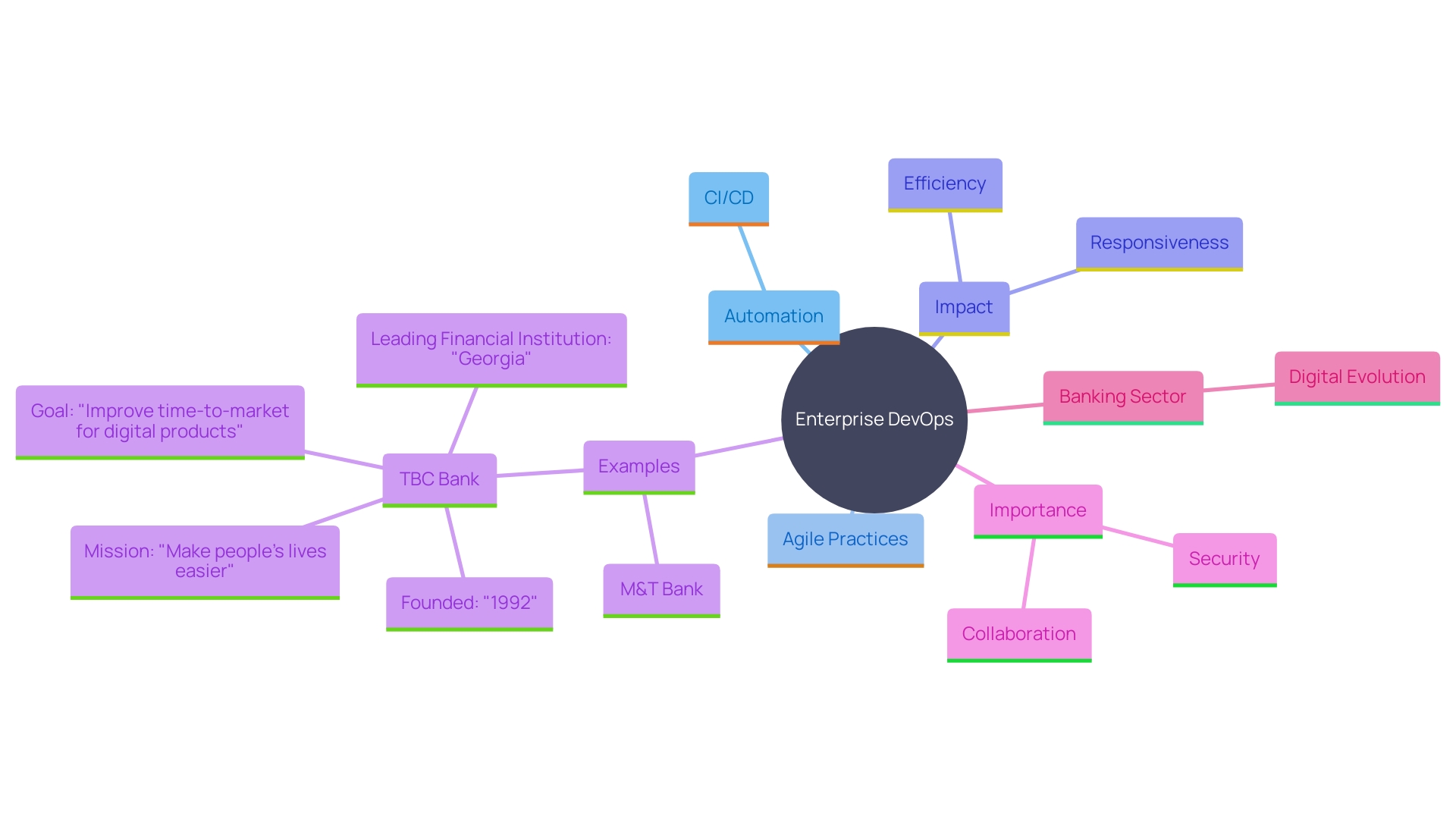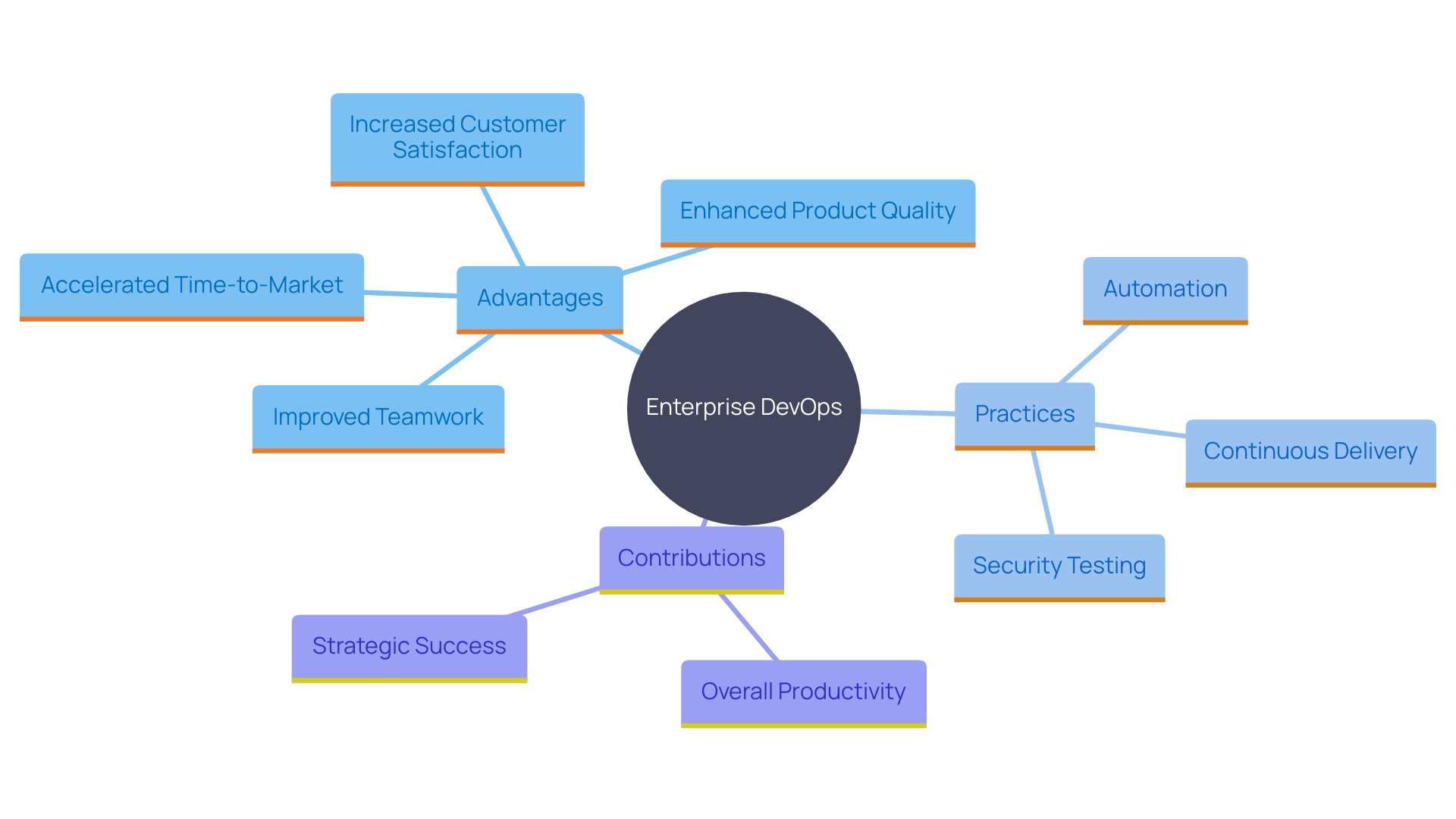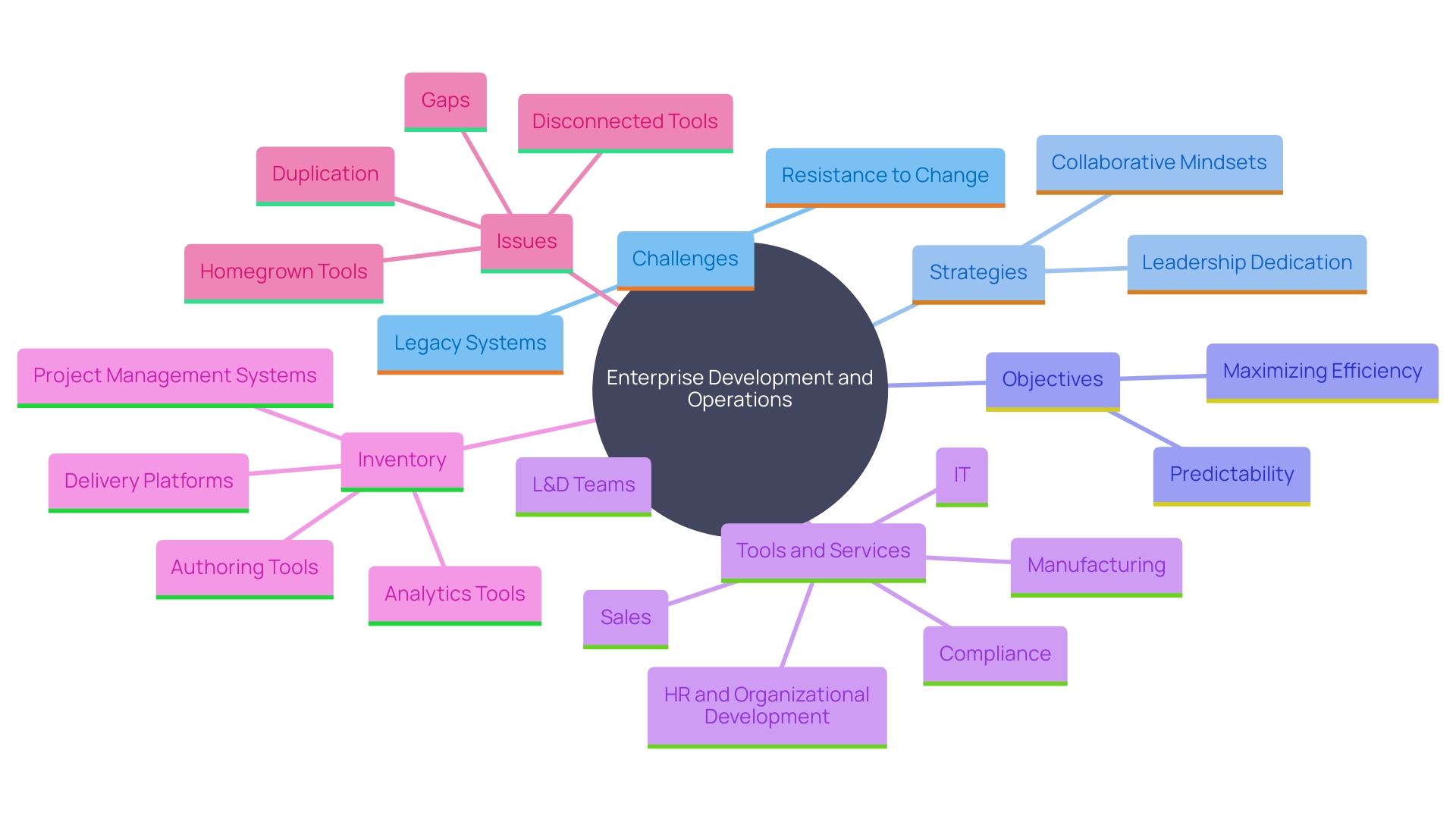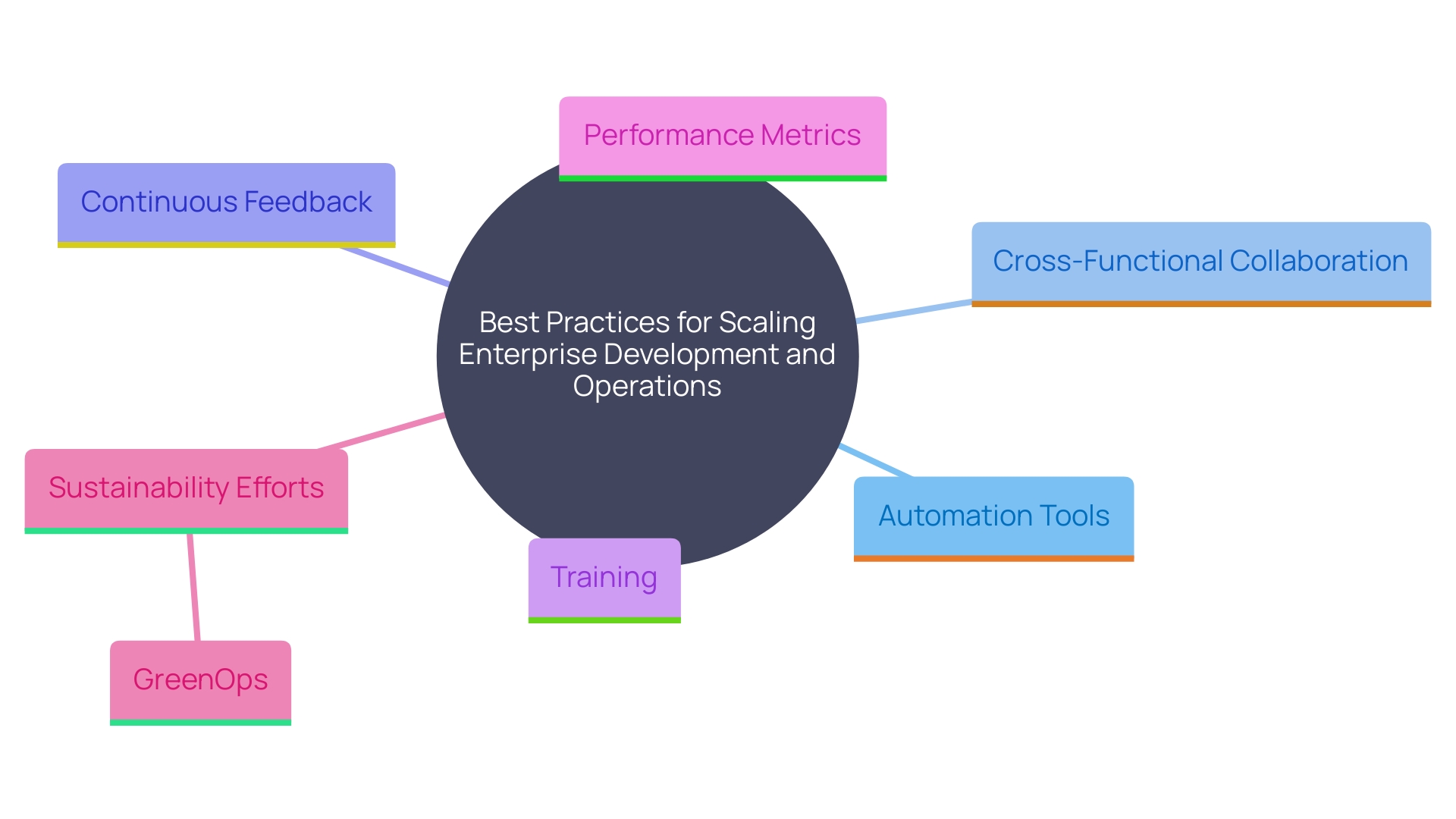Introduction
In today’s rapidly evolving technological landscape, the seamless integration of development and operations within large-scale organizations has become paramount. Enterprise DevOps stands at the forefront of this transformation, promising enhanced collaboration, streamlined processes, and a significant boost in efficiency. By leveraging automation, continuous integration, continuous delivery, and agile practices, organizations can not only optimize their software development lifecycle but also foster a culture of shared responsibility and accountability across teams.
This methodology has proven indispensable for industries such as banking, where the rapid and secure delivery of software updates is crucial for maintaining a competitive edge and ensuring regulatory compliance. As businesses strive to innovate and meet market demands, the adoption of Enterprise DevOps emerges as a critical driver of strategic success and operational excellence.
Definition of Enterprise DevOps
Enterprise DevOps entails the smooth combination of software creation and operations within large-scale enterprises to promote improved teamwork and optimize processes. This methodology leverages automation, continuous integration (CI), continuous delivery (CD), and agile practices to significantly improve efficiency and responsiveness to market demands. By automating core aspects of the software creation lifecycle (SDLC), such as configuration management, infrastructure as code (IaC), and monitoring, organizations can reduce overhead and expedite time-to-market.
This approach not only optimizes the software development lifecycle but also cultivates a culture of shared responsibility and accountability across teams. For instance, TBC Bank has successfully embraced a collaborative development approach to improve their time-to-market for digital products, resulting in enhanced customer experiences and operational efficiency. Similarly, M&T Bank implemented organization-wide Clean Code standards to ensure their software maintains high-quality standards, thereby supporting maintainability and performance.
The banking sector, amid its significant digital evolution, illustrates the need for collaborative development and operations. The emphasis on security and compliance is paramount, especially considering the high stakes of financial transactions and sensitive data. 'Development and operations practices enable banks to deliver software updates rapidly and securely, which is crucial in maintaining a competitive edge and ensuring regulatory compliance.'. As evidenced by leading institutions, the adoption of development and operations practices has become indispensable in driving innovation and achieving strategic business goals.

Benefits of Enterprise DevOps
Implementing Enterprise DevOps brings numerous advantages, such as accelerating time-to-market, enhancing product quality, and boosting customer satisfaction. By combining creation and operations, organizations encourage improved teamwork, resulting in more innovative solutions. Automating repetitive tasks minimizes human mistakes and allows groups to concentrate on high-value activities, fostering business growth.
The practice combining software creation and operations seeks to reduce the system's lifecycle and guarantee ongoing delivery with high software quality. This methodology tackles the frequent issue of delays in launching new versions caused by miscommunication among different groups. By dismantling these barriers, the approach aids in shortening the turnaround duration for software updates, ensuring that development groups comprehend the production setting and evaluate their code under authentic circumstances.
In today's dynamic work environment, swift delivery and reduced turnaround time are crucial. The implementation of development and operations practices becomes essential, producing top-notch output with minimal post-production errors. For instance, the stress of introducing new features or upgrades can disrupt workplace stability. However, collaborative practices establish a stable work environment by maintaining continuous improvement and seamless communication between teams.
Furthermore, practices in this field enable organizations to operate at the required speed to innovate quicker, adjust to evolving markets, and achieve business outcomes more effectively. 'The incorporation of automated, cohesive security testing tools guarantees that embracing a development and operations model does not jeopardize security.'. This comprehensive approach maximizes predictability, efficiency, security, and sustainability of operational processes, ultimately enhancing the overall productivity and strategic success of engineering teams.

Challenges in Implementing Enterprise DevOps
Implementing Enterprise Development and Operations often brings considerable difficulties for companies. Resistance to change, cultural barriers, and the presence of legacy systems can impede implementation efforts. Surmounting these challenges requires a robust leadership dedication and an emphasis on cultivating a collaborative mindset across the organization.
In large enterprises, aligning teams around common goals and metrics can be particularly challenging due to disparate processes and tools. As stated in the Accelerate State of Development Operations Report, engineering effectiveness is a universal necessity and significantly influences productivity, responsiveness, and strategic success. It is essential for entities to drive this effectiveness to overcome implementation hurdles.
For instance, TBC Bank, a leading financial institution in Georgia, successfully transformed its large-scale operations to achieve flexible and continuous delivery of value. By prioritizing the improvement of time-to-market for digital products, TBC Bank has enhanced the banking experience for both customers and employees. This transformation underscores the importance of a unified strategy and the delegation of authority to specialists, minimizing top management's involvement.
Furthermore, the main objective of the development and operations approach is to maximize predictability, efficiency, security, and sustainability of operational processes. This approach encourages teamwork and ongoing enhancement, allowing entities to react promptly to market needs and client input. Such a strategy is essential for enterprises aiming to maintain a competitive edge in the rapidly evolving technology landscape.

Best Practices for Scaling Enterprise DevOps
To effectively scale Enterprise development and operations, organizations should adopt best practices that encompass a robust automation toolchain, cross-functional collaboration, and continuous feedback loops. Implementing an advanced toolchain for automation is pivotal in optimizing workflows and minimizing manual interventions. Creating cross-departmental groups guarantees that creation and operations are smoothly combined, promoting an environment of cooperation and common goals. Continuous feedback loops enable swift identification and resolution of issues, enhancing the overall efficiency and reliability of the delivery pipeline.
Investment in training and development is essential to prepare teams with the necessary skills and knowledge to utilize practices effectively. Regularly measuring performance through key metrics provides insights into areas that require improvement and helps align technological initiatives with business goals. For instance, TBC Bank's transformation towards flexible, continuous delivery has significantly improved its time-to-market for digital products, thereby enhancing customer and employee experiences.
Additionally, organizations must focus on sustainability aspects such as GreenOps, which minimizes the carbon footprint of cloud environments through efficient resource utilization. Bosch's efforts in building energy-efficient data platforms exemplify the positive impact of integrating sustainability with technological advancements.
By adhering to these best practices, enterprises can ensure that their DevOps initiatives not only drive efficiency and agility but also align with broader organizational goals and regulatory requirements, as demonstrated by M&T Bank's adoption of Clean Code standards to maintain robust and compliant software operations.

Conclusion
The integration of Enterprise DevOps is essential for large-scale organizations aiming to enhance collaboration and streamline processes, particularly in sectors requiring rapid and secure software delivery. By utilizing automation, continuous integration, continuous delivery, and agile practices, organizations can significantly boost efficiency and responsiveness. Success stories from TBC Bank and M&T Bank illustrate the importance of fostering a culture of shared responsibility.
The advantages of adopting Enterprise DevOps include faster time-to-market, improved product quality, and increased customer satisfaction. By dismantling silos between development and operations teams, organizations can innovate more effectively and reduce turnaround times for software updates. Moreover, automated security testing ensures operational security without compromising efficiency.
Despite these benefits, challenges such as resistance to change and legacy systems can hinder implementation. Overcoming these obstacles requires strong leadership and a cohesive strategy that aligns teams around shared goals. Implementing best practices, like cross-functional collaboration and continuous feedback loops, is crucial for effectively scaling DevOps initiatives.
In summary, adopting Enterprise DevOps is vital for organizations that seek to maintain a competitive edge in a fast-evolving technological landscape. This methodology optimizes the software development lifecycle while fostering a culture of innovation and collaboration that aligns with broader business objectives.




